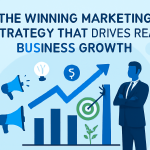Now Reading: The Winning Marketing Strategy That Drives Real Business Growth
-
01
The Winning Marketing Strategy That Drives Real Business Growth
The Winning Marketing Strategy That Drives Real Business Growth

Effective marketing is the foundation of long-term, scalable company growth, not just a slogan. Developing a successful marketing plan in the fiercely competitive digital world of today necessitates matching your objectives with doable steps that yield quantifiable outcomes. With an emphasis on digital and content marketing as the cornerstones of successful campaigns, this all-inclusive guide will take you through each stage of creating a solid marketing plan. being aware of the fundamentals of an effective marketing strategy.
At its heart, a winning marketing strategy is a well-defined plan that blends creativity, data, and market insight to achieve long-term success. It doesn’t rely on trends alone—it’s grounded in your brand’s unique value proposition and clearly mapped customer journeys.
A successful strategy starts with research: understanding your audience, their behaviors, pain points, and motivations. This foundational step ensures your digital marketing strategy is not only relevant but impactful. Using tools like customer personas, competitive audits, and industry benchmarks, businesses can design marketing frameworks that truly resonate.
Additionally, the content marketing strategy should align with the broader business goals—whether it’s increasing brand awareness, boosting lead generation, or driving sales. Messaging must be consistent across channels, and KPIs should be tracked meticulously to refine the strategy over time.
Setting SMART Goals to Guide Your Marketing Efforts
Without clear objectives, even the most creative campaigns can fall flat. A winning marketing strategy hinges on SMART goals: Specific, Measurable, Achievable, Relevant, and Time-bound. These criteria ensure your team focuses on the right activities and maintains accountability.
For example, if one of your business goals is to grow organic traffic by 30% in six months, your content marketing strategy should include keyword-focused blog posts, optimized landing pages, and regular performance tracking. Similarly, your digital marketing strategy might involve retargeting campaigns and SEO improvements aimed at long-term visibility.
Each goal must serve a purpose. Instead of vague aspirations like “increase social media followers,” a SMART goal might be “gain 1,000 new Instagram followers in 90 days through weekly Reels and targeted ads.” This approach not only enhances business growth but also helps optimize budget and time investments.
Creating a Customer-Centric Marketing Plan
Your audience should sit at the center of every winning marketing strategy. A customer-centric approach means tailoring your tactics to meet real needs, build trust, and nurture long-term loyalty. This approach fosters meaningful engagement, not just one-time conversions.
Segmentation is key. Group your audience by demographics, behaviors, and preferences, then create personalized experiences. Whether through email marketing, dynamic content, or targeted social ads, your digital marketing strategy should deliver value at every touchpoint.
Customer-centric thinking also helps your content marketing approach. Utilize case studies, videos, and blog entries to address frequent issues, respond to inquiries, and offer sincere assistance. Data-driven delivery coupled with empathy in messaging increases brand attachment and propels ongoing company expansion.
Leveraging Digital Channels for Maximum Reach
No winning marketing strategy is complete without a robust digital marketing strategy. Social media, email platforms, search engines, and paid advertising networks all have a significant impact on today’s marketing environment and present different chances to engage with your target audience.
SEO is a foundational tactic that boosts organic visibility. Combined with PPC campaigns, social media marketing, and email nurturing sequences, it creates a powerful ecosystem that supports long-term results. Don’t just focus on being present—focus on being effective.
A content marketing strategy complements these efforts by supplying valuable, shareable, and evergreen assets. Blogs, infographics, webinars, and podcasts help you own your niche and increase credibility. Together, these strategies enhance brand exposure and contribute directly to business growth.
Crafting High-Impact Content That Converts
Quality content is the engine of any winning marketing strategy. In an age where attention is the new currency, your content marketing strategy must be designed to educate, inspire, and drive action.
Start by identifying core topics your audience cares about. Then, map each piece of content to a stage in the buyer’s journey—awareness, consideration, or decision. This ensures relevance and maximizes engagement. Every blog post, whitepaper, or video should have a clear purpose and CTA.
`Integrating Automation and AI into Your Strategy
Technology plays a critical role in a winning marketing strategy. Marketing automation tools and AI-powered analytics not only save time but enhance personalization and scalability.
Platforms like HubSpot, Marketo, and ActiveCampaign can automate email workflows, lead scoring, and campaign reporting. This makes it easier to implement a strategic digital marketing strategy across multiple channels without overwhelming your team.
AI tools can assist in content creation, customer segmentation, and predictive analytics—allowing your content marketing strategy to stay ahead of trends and tailor messaging more accurately. Automation ensures consistency, while AI boosts performance—both vital for business growth.
Measuring and Analyzing Marketing Performance
No winning marketing strategy is complete without a robust analytics framework. You must understand what’s working and what isn’t to optimize future efforts and ensure ROI.
Key performance indicators (KPIs) like conversion rates, customer acquisition cost (CAC), and lifetime value (LTV) should be monitored consistently. Tools like Google Analytics, SEMrush, and HubSpot give clear insights into your digital marketing strategy’s effectiveness.
Engagement indicators like time on page, bounce rate, and social shares should be used to assess your content marketing approach. To achieve sustainable business success, data should inform all choices, from budget reallocation to messaging refinement.
Aligning Sales and Marketing Teams for Unified Growth
Sales and marketing alignment is a hallmark of a winning marketing strategy. When these departments collaborate, businesses experience higher lead conversion rates, better customer experiences, and faster business growth.
Use shared tools like CRMs and create joint KPIs. Encourage open communication about customer feedback and campaign performance. A unified message ensures that prospects receive a seamless journey from first touchpoint to closed deal.
This alignment helps your content marketing and digital marketing strategies since they can be improved based on real-time sales data. Better leads are more important than just more leads.
Scaling Your Strategy for Sustainable Business Growth
Once you’ve found a winning marketing strategy that works, the next challenge is scaling it effectively. This requires systems, team training, and continual optimization.
Invest in tools that support growth—whether it’s marketing automation, content management systems, or data platforms. Document your processes and build repeatable workflows. Scaling also involves identifying which tactics yield the best ROI and doubling down on them.
As your digital marketing strategy evolves, your content marketing strategy should too. Refresh outdated content, test new formats, and expand into new channels like podcasting or video series. Scaling with intention ensures your brand continues to achieve significant and sustainable business growth.
Conclusion: Your Roadmap to a Winning Marketing Strategy
Developing a winning marketing strategy isn’t a one-time task—it’s an ongoing commitment to improvement, adaptation, and excellence. By aligning your goals with audience needs, leveraging the right digital channels, crafting compelling content, and continuously measuring results, you build a system that not only attracts but retains and converts.
A strong digital marketing strategy coupled with a dynamic content marketing strategy forms the foundation for enduring business growth. Now’s the time to audit your current approach, identify gaps, and take action. Your roadmap is here—start implementing your winning strategy today and watch your business soar.
Personalizing Customer Experiences for Competitive Advantage
One of the most powerful elements of a winning marketing strategy is personalization. Today’s consumers expect tailored experiences that acknowledge their preferences, behaviors, and unique needs. Generic, one-size-fits-all campaigns no longer suffice. Brands that invest in personalization not only increase engagement but also build trust and loyalty that fuels long-term business growth.
Personalization begins with data. Leveraging first-party and behavioral data enables marketers to segment audiences effectively and create targeted messaging across all touchpoints. Whether it’s an email campaign, website experience, or ad retargeting, personalization transforms interactions from transactional to relational. A solid digital marketing strategy incorporates AI-driven personalization engines, dynamic content, and smart product recommendations to deliver this kind of experience at scale.
Your content marketing strategy should follow suit by creating topic clusters tailored to specific customer segments. For instance, a B2B software company might produce separate content streams for IT managers and CFOs, each addressing their unique challenges and objectives. Personalized calls to action, custom landing pages, and interactive tools further enhance relevance and conversion rates.
Ultimately, personalization ensures that your winning marketing strategy resonates deeply with customers, setting your brand apart in crowded markets and accelerating business growth in measurable ways.
Mastering Social Media to Amplify Brand Reach
Social media platforms are no longer just optional channels—they’re essential elements of any winning marketing strategy. These platforms offer unmatched potential to build community, foster brand loyalty, and drive meaningful engagement. From Instagram and LinkedIn to TikTok and YouTube, social media is a vital component of both your digital marketing strategy and your overall marketing ecosystem.
To succeed, your approach must be platform-specific and audience-aware. Start by understanding where your target demographics spend their time and tailor content formats accordingly. Visual storytelling works best on Instagram, while thought leadership thrives on LinkedIn. Your content marketing strategy should reflect this diversity by creating custom visuals, videos, carousels, and stories that align with platform algorithms and user behaviors.
Consistency is also crucial. A well-maintained content calendar ensures a steady stream of brand messaging that reinforces your value proposition. Influencer partnerships, live Q&As, and user-generated content campaigns can boost visibility and authenticity. Additionally, paid social ads enhance your reach, particularly when combined with retargeting and precise demographic targeting.
By leveraging social media strategically within your winning marketing strategy, brands can not only expand reach but also drive conversions, deepen relationships, and create emotional connections that result in sustainable business growth.
Optimizing for Search: SEO as a Pillar of Growth
Of all digital marketing strategies, SEO provides the highest long-term return on investment (ROI) because over 90% of online interactions start with a search engine. By optimizing your website and content for search intent, you can create a consistent flow of organic traffic that raises awareness, leads, and conversions. On-page SEO elements like image alt tags, internal linking, meta descriptions, and keyword-rich headers increase the discoverability of content. Reputable guest posts and high-quality backlinks support off-page SEO by progressively raising your domain authority. A technical SEO foundation that ensures search engines can efficiently crawl and index your website must include elements like mobile optimization, fast site speed, and clean architecture.
Customer-centric thinking also helps your content marketing approach. Utilize case studies, videos, and blog entries to address frequent issues, respond to inquiries, and offer sincere assistance. Data-driven delivery coupled with empathy in messaging increases brand attachment and propels ongoing company expansion.
SEO isn’t a one-time tactic; it’s a long-term commitment baked into every stage of a winning marketing strategy. When executed well, it becomes a growth engine that continually fuels awareness, engagement, and sustainable business growth without relying solely on paid channels.
Embracing Video Marketing for Deeper Engagement
A successful marketing strategy must include video marketing, which has become a game-changer in contemporary business strategies. With sites like Instagram Reels, TikTok, and YouTube capturing users’ attention, video is now expected rather than optional. Businesses that use video stand out, gain consumers’ trust more quickly, and interact with them more fully. Video excels at simplifying complex ideas, humanizing brands, and creating memorable storytelling experiences. Whether it’s product explainers, behind-the-scenes footage, tutorials, or customer testimonials, video content adds a dynamic element to your content marketing strategy that static formats can’t match.
From an SEO perspective, video boosts dwell time on pages and can significantly improve rankings when properly optimized with transcripts, titles, and metadata. Embedding videos in blog posts or on landing pages can also increase conversions by reinforcing key messages and making CTAs more compelling.
Compared to other formats, video advertising typically have better engagement and higher click-through rates in your digital marketing plan. Webinars, interactive video content, and live video create new avenues for community development and consumer connection.A winning marketing strategy that incorporates video demonstrates agility and innovation, offering consumers a rich, multisensory experience that drives stronger relationships and faster business growth.
Building a Strong Brand Identity That Resonates
A cohesive brand identity is the soul of a winning marketing strategy. It’s more than a logo or color palette—it’s how your business communicates, behaves, and connects emotionally with your audience. Without a strong identity, even the most technically sound digital marketing strategy will fall flat.
Brand identity encompasses your tone of voice, visual aesthetics, core values, and overall personality. Consistency across channels—from your website and social media to ads and email—is key to creating recognition and trust. This alignment ensures that every customer interaction reinforces your unique value proposition.
Your content marketing strategy should act as the vehicle that brings your brand identity to life. Every blog post, newsletter, and campaign should feel unmistakably “you.” Stories, values, and user testimonials can be powerful storytelling tools that differentiate your brand in the minds of consumers.
Audiences are more likely to become devoted supporters and repeat customers when they identify with your brand identity. The ultimate goal of a successful marketing plan aimed at actual and long-lasting business growth is to convert casual browsers into lifelong clients through this emotional connection.
Maximizing Conversion Through Effective Funnels
A winning marketing strategy is only successful if it drives conversions, and that requires a well-designed marketing funnel. This structured journey—from awareness to action—guides prospects step-by-step toward becoming loyal customers. If your funnel is leaky or poorly optimized, your entire digital marketing strategy could fail to produce ROI.
Start by analyzing each stage of the funnel: Awareness, Interest, Consideration, and Conversion. At the top, your focus should be on traffic-driving tactics such as SEO, paid ads, and social media. As prospects move down the funnel, nurture them with personalized emails, informative content, and strategic retargeting.
A well-integrated content marketing strategy supports each phase. Educational blog posts build awareness, while case studies and comparison guides aid in the consideration stage. Webinars, demos, and testimonials drive the final push to conversion. Your content must not only inform but also guide, motivate, and persuade.
CTAs should be clear and compelling, and landing pages must be optimized for both mobile and desktop users. A/B testing and heatmap analytics can help you refine layouts and messaging over time. A streamlined, high-converting funnel ensures your winning marketing strategy turns attention into revenue—and fuels continuous business growth.
Staying Agile: Evolving With Market Trends
A good marketing strategy must be agile in the ever evolving digital environment. A rigid methodology quickly becomes outdated due to the constant changes in customer behavior, platform algorithms, and market conditions. Businesses that remain proactive and flexible are the ones that thrive.
Agility means regularly reviewing performance data and being willing to pivot when something isn’t working. This includes testing new channels, adjusting ad budgets, or refreshing your content marketing strategy based on feedback and trends. It also means staying informed—watching competitor movements, new technology, and cultural shifts that affect customer expectations.
Incorporating agile methodologies into your digital marketing strategy allows you to experiment with low-risk pilot campaigns, gather insights, and then scale what works. This “test, learn, optimize” approach ensures that your marketing efforts remain relevant, effective, and aligned with business goals.
Ultimately, a winning marketing strategy isn’t about sticking to a rigid script—it’s about adapting intelligently. Businesses that master agility not only weather disruption but often come out ahead, leveraging change as a competitive edge and driving consistent business growth over time.










